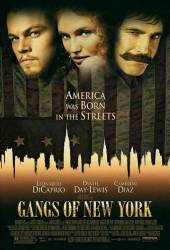Factual error: In one scene where Bill is in the Mayor's office, the mayor is sitting behind his desk and holding a bunch of papers, and on the upper right hand corner of the papers is a paper clip. Paperclips were not invented until 1899. (00:21:15)
Factual error: In the funeral procession scene, the priest is wearing the maniple on the wrong arm. The maniple is a 2 ft strip of ornate cloth prescribed for use in the Catholic Mass before Vatican II in the early 1960s. It is actually worn of the left forearm; however, in this scene it is on the priest's right. (00:49:10)
Factual error: In a scene set in 1862 or 1863 Bill the Butcher says: 'An Irishman will do for a nickel what a ****** will do for a dime or a white man for a quarter'. The first nickel 5 cent piece was coined in 1866. At the time of the scene the 5 cent coin was a small silver coin called a half-dime. (01:10:00)

Factual error: When Amsterdam kills the man that shot Bill the Butcher in the shoulder at the theater, you can see bananas on the floor. Bananas were traded in the U.S. only after the Civil War. (01:13:50)
Factual error: The Snooker scene appears incorrect, since the earliest form of Snooker was invented in India circa 1875 - by British soldiers. At any rate, the blue ball shown in the movie was not added to the game until even later. (02:15:00)
Factual error: When the Lords and posh folk are playing snooker they are using plastic tipped cues with blue chalk on the tip. These would not have been used in this time period. (02:15:30)
Factual error: The prayer uttered at the beginning of the movie ("Saint Michael, the Archangel, defend us in battle; be our protection against the wickedness and snares of the devil") was composed by Pope Leo XIII in the year 1884. The movie is set during the American Civil War in the 1860's.
Factual error: In the scene when Bill is throwing knives at the girl, right after he comes off the stage, the flag that drops as the band comes out has 50 stars on it.
Suggested correction: The flag in the movie has 34 stars in it. Thank you for great observation.
Factual error: The lords are playing Snooker in a scene. This movie is set in 1862. Snooker was not invented till 1875.
Factual error: At the end of the movie (before the credits roll) you see the skyline of modern New York, with the World Trade Center Towers included. As patriotic as this is, the towers are placed incorrectly in relation to the Brooklyn Bridge. They should be more to the left.





